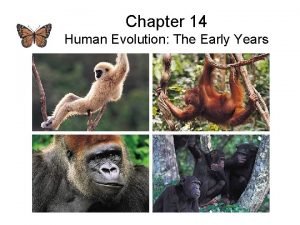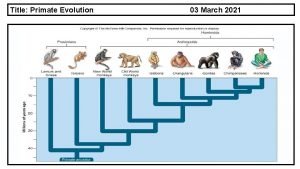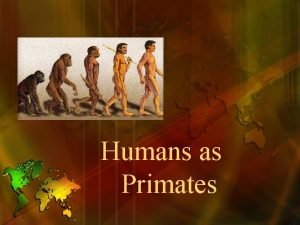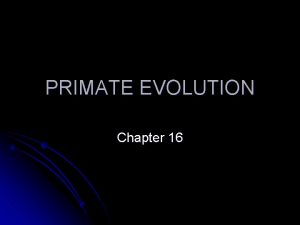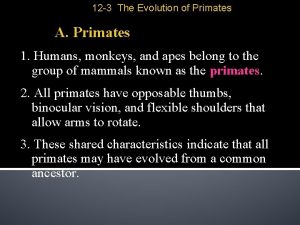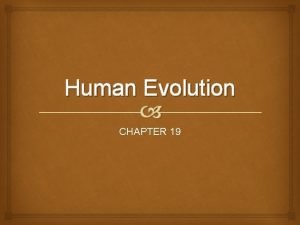14 1 The Evolution of Primates I Primate










- Slides: 10

14. 1 The Evolution of Primates I. Primate Characteristics A. Charles Darwin 1. In book The Decent of Man, he proposed that humans, gorillas, & chimpanzees all evolved from a common ancestor. B. Primate evolution begin 80 m. y. a. 1. only small insect eating mammals about the size of human fist 1

C. Two distinct changes 1. Development of grasping fingers & toes with nails not claws a. useful in climbing, seizing food, using tools, etc 2. Change in position of eyes to front of face a. allows for “binocular vision” which can judge distance better 1. important for an animal that leaps from branch to branch 2

II. First primates A. Prosimians – means “before apes” 1. very few survive today a. examples – lorises, tarsiers, lemurs B. Lemurs 1. about the size of a house cat 2. use long tail to balance while in trees 3. expanding human population has brought close to extinction 3

4

III. Monkeys A. Diurnal 1. active during the day and asleep at night B. Cone Cells 1. located in the back of the eye, allow for color vision 2. accompanied by the development of larger more complex brains C. Opposable thumbs 1. monkeys were first to develop this 2. stands out at angle from other fingers, can be bent in to grasp D. Evolved in Central Africa first and spread to Asia 5

1. Old World Monkeys = Asia & Africa 6

2. New World Monkeys = Central & South America 7

IV. Path to humans A. Fossil evidence indicates that humans evolved from apes B. Modern apes 1. gibbons, orangutans, gorillas, chimpanzees, & pygmy chimpanzees 8

9

2. larger more developed brains than monkeys 3. none have tails 4. none ever reached North & South America C. Human and chimpanzee DNA only differs by 1. 6% D. Your hemoglobin (composed of 583 amino acids) only differs from a chimpanzees by a single amino acid. 10
